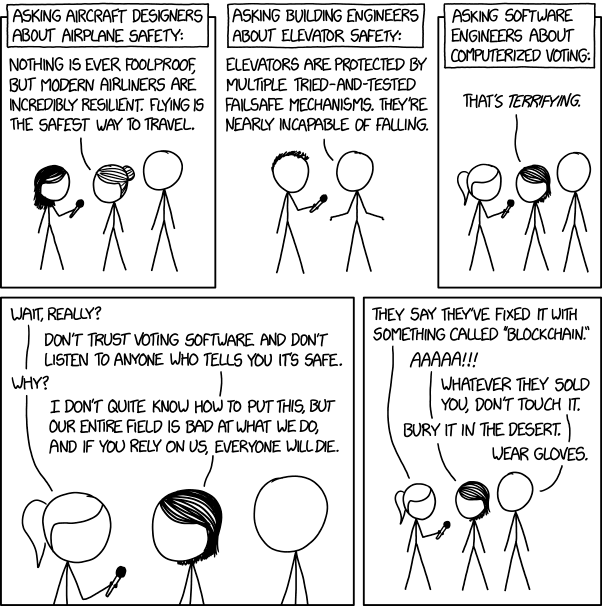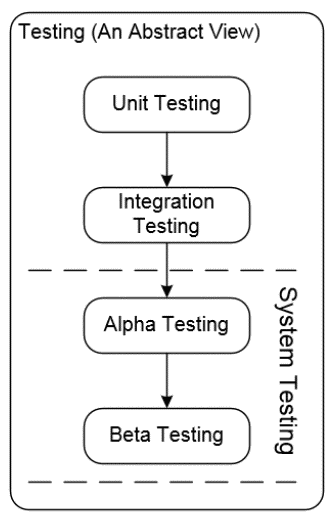Software Quality Assurance
An Introduction
|
|
Prof. David Bernstein
James Madison University
|
|
| Computer Science Department |
| bernstdh@jmu.edu |

|
Getting Started
- Definition:
-
Quality assurance (QA) is a systematic pattern
of activities intended to ensure that a product properly
satisfies the needs and desires of its stakeholders.
- Activities:
-
Validation is the process of determining if a product
(or its specification) satisfies stakeholders' needs and
desires ("Are we building the right product?")
-
Verification is the process of determining if a
product (or its specification) satisfies those needs and
desires properly ("Are we building the product right?")
An Example
- The Setting:
- You are a newspaper reporter and you are told to write an
article about homelessness (the product)
- Validation:
- You must write about homelessness
- Note: All validation activities are product specific
- Verification:
- You must write properly (e.g., use proper grammar, follow the
newspaper's style guide, make a compelling argument)
- Note: Some verification activities are product-specific
(e.g., the quality of the argument) and some are not (e.g.,
proper grammar)
Software Quality - History
- Conformance to Specifications (Crosby, 1979):
- Items that are verified (i.e., the reliability, robustness,
and safety of the product)
- Customer Satisfaction (Feigenbaum, 1983):
- Items that are validated (i.e., the adequacy of the product)
History (cont.) - Boehm et al. (1978)
- As-Is Utility:
- Portability
- Reliability
- Efficiency
- Human Engineering
- Maintainability:
- Testability
- Understandability
- Modifiability
History (cont.)
- Garvin (1984):
- Transcendental View - I know it when I see it
- User View - fitness for purpose
- Manufacturing View - conformance to specifications
- Product View - tied to inherent product characteristics
- Value-Based View - tied to what the customer is willing to pay
- Garvin (1988):
- Performance
- Features
- Reliability
- Conformance
- Durability
- Serviceability
- Aesthetics
- Perceived Quality
The Modern Perspectives - ISO/IEC 25010
- Functional Suitability:
- Functional completeness, correctness, and
appropriateness
- Performance Efficiency:
- Processing times and throughput rates,
resources used, capacity
- Compatability:
- The degree to which the product can co-exist with
and interoperate with other products
The Modern Perspectives - ISO/IEC 25010 (cont.)
- Usability:
- Understandability, learnability, and
operability
- Security:
- Confidentiality, integrity, authentication, and
accountability
- Maintainability:
- Modifiability/Adaptability and
reusability
Software Products vs. Large-Scale Engineering Products
- Examples:
- Structures (bridges, buildings, dams)
- Networks (e.g., roads, water, electrical, communication)
- How is Quality Defined?
Software Products vs. Large-Scale Engineering Products (cont.)

(Courtesy of xkcd)
Software Products vs. Manufactured Products
- Other Products:
- After the product is designed and engineered it must be
produced/manufactured and each instance is different
- The concern is often with the quality of the instances
of the product (sometimes called "quality control")
- Software Products:
- After the product is designed and engineered each instance
is identical
- The concern is with the quality of the product
Defect Elimination:
- Defects:
- Any undesirable aspect of a product
- Defect Elimination Activities:
- Prevention
- Detection and Removal
Defect Prevention
- Process Guides:
- Standards and guidelines that describe the way everyone
in the organization should behave
- Templates and checklists that make it easier to do so
- Analysis and Design Methodologies:
- Well-codified approaches to understanding and solving
software-related problems (e.g., OO)
- Well-Studied Solutions:
- Reference architecture
- Design patterns
Defect Prevention (cont.)
- Prototypes:
- Throwaway/Exploratory
- Evolutionary
- Tools:
- Version/configuration management
- Computer-aided software engineering (CASE)
Defect Detection and Removal
- Review and Correct:
- Automated tools
- Manual techniques (e.g., desk-checks, walk-throughs,
inspections)
- Test and Debug:
-
Testing is a validation and verification process that
makes use of the system/product (including prototypes)
while it is in operation or being operated on
An Abstract View of Testing
Quality of the Process
- An Observation:
- Many activities affect product quality
- Questions One Might Ask:
- When are we finding particular validation problems
and can we find them earlier?
- When are we finding particular verification problems
and can we find them earlier?
- Implications:
- The quality of the process can be an important determiner
of the quality of the product
Organizing for Quality
- Root Causes of Quality Problems:
- Management tends to blame workers
- Workers tend to blame managers
- Implications (Feigenbaum, 1983):
- Quality shouldn't be the responsibility of a single department
- Quality must be part of the entire process
Approaches/Methodologies/Standards
- Quality Circles:
- A small group that meets on a regular basis to consider
quality issues for its "department" and make recommendations
to management
- Six Sigma (ISO 13053:2011):
- Plan-Do-Check-Act (Demming)
- Continuously monitor products and processes (engineering and
management processes)
- Focus on achieving measurable improvements and confirming
them with statistical analyses
- Well-Defined Rolls (Executives, Champions,
Master Black Belts, Black Belts, Green Belts)
- ISO 9001:
- Must have a formal statement of a quality policy that is
understood and applied at all levels
- Must make decisions based on audited data
- Must communicate with the customer and obtain feedback
from the customer
Approaches/Methodologies/Standards (cont.)
- Capability Maturity Model (CMM):
- Initial
- Repeatable (requirements management, project planning,
project tracking)
- Defined (process focused, integrated management, peer reviews,
coordination)
- Managed (quantitative)
- Optimizing (fault prevention, change management)
- Software Process Improvement and Capability Determination (SPICE) - ISO15504:
- Performed informally
- Planned and tracked
- Well-defined
- Quantitatively controlled
- Continuously improving
The Quality Tradeoff
- Costs of Low Quality Software:
- Negligence and liability costs
- Security costs
- Disgruntled customers (hence lost sales)
- Costs of High Quality Software:
- Prevention costs
- Appraisal costs
- Delays to market (hence lost sales)
The Quality Tradeoff (cont.)

(Courtesy of xkcd)


